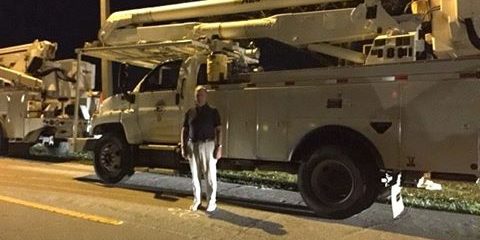I got the question too often, my answers were always unconvincing, so I asked Ted Fletcher, who runs Vero Electric, to help me understand their task of restoring power after a major storm.
Ted took me around to different sites on Sunday night, and explained that when the winds die down, they do a survey of their territory, noting the damages, figuring what it would take to repair everything within a reasonable time frame, and then determine the number of crews they will need to supplement Vero’s. This year there were 103 linemen in town from Georgia and Nebraska, with their trucks. After the emergency areas are fixed, like hospitals, they assign teams to areas where they will get the most people up with the least amount of effort, generally moving systematically, East to West, or North to South. It’s all very democratic. Once the easy fixes are done, then they get down to the hard, and then very hardest issues, which may take as many as 9 people 4 hours to get one house back on line (an actual case on Sunday).
This year there were 16 of the 44 distribution feeders that did not lose electricity, about 36% of the total 34,000 customers. Of the other 64%, most were not difficult situations, so that 90% were up by Saturday night, and 99% by Sunday night, leaving only hard jobs that affected 200 customers for Monday and possibly Tuesday. The crews meet for planning and breakfast at 6:00 am in a big tent near the airport, and close down between 8:30 pm and 10:00 pm depending on the issue. I have attached a picture of Sunday dinner at 8:00pm showing some of the trucks and crew.
After seeing Vero Electric in operation, and understanding the planning and the number of people and hours addressed to the task, it is much easier to tell people with confidence that your problem is known, there are crews working toward your area, and your electricity will come on as soon as they can get to it. Please be patient.
Randy







